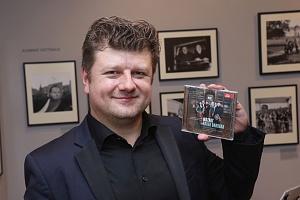
RADEK BABORÁK
GENERIC INTERVIEW


In October 2018, Supraphon released the album of Mozart's Sinfonia Concertante and Music for French Horn recorded by Radek Baborák, the Baborák Ensemble, the hornist Radovan Vlatković, the oboist Clara Dent-Bogányi, the flautist Walter Auer and the bassoonist Bence Bogányi. We asked Radek Baborák a couple of questions about the recording.
Mr. Baborák, how has your relation to Mozart evolved?
The very first small piece I played was the second movement from Mozart’s Horn Concerto No. 3. I was nine or so years of age and I now I can refer to the moment as the beginning of my relation to Mozart’s music for the horn. And owing to the fact that Mozart’s concertos are part of the compulsory repertoire at competitions and auditions, over a certain period I actually performed them a lot. Yet when I was about 20, I started to play more pieces by Classical composers – Joseph Haydn, Antonio Rosetti, Jan Václav Stich-Punto, František Pokorný, Carl Stamitz, and others. After a certain time, however, I returned to Mozart and realised how magnificent his music for the horn was. Making do with a modicum of notes, he was capable of discovering new characters and intriguing sounds in each instrument. His music harbours great imagination and a plethora of colours, which can be sensed from the score. I myself consider every tiny fragment of Mozart’s pieces far more valuable than whole concertos by lesser-known composers.
You spent many years abroad, primarily in German-speaking countries. Does the approach to interpreting Mozart’s music there anyhow differ from that in the Czech Republic?
As I perceive it, the difference in interpretation of music dating from the Classical period is very slight. The natures of individual nations naturally do indeed have a certain impact on the approach to music, so we can assume that, for instance, the Italians would perform Mozart’s scores more vividly, the Germans more earthily, and the like. But when it comes to Classicist music, one can hear all the details, while its order, preciseness, articulation, intonation and phrasing must be uncompromisingly taken heed of by each and every performer. And despite its stylishness, Classicist music must remain zesty, humorous and joyous, replete with surprises and possessing a charge, which is afforded to it by the “pattering” of the ostinato. By their simple themes, the fast movements are actually reminiscent of rock and roll – a spread chord at the beginning and off it goes rushing!
Within your new album, you adapted the sinfonia’s unused movement so as to complete the missing parts of the unfinished horn concerto. Can we assume that this was the commencement of your work as a composer?
In no case would I be able to complete Mozart’s pieces, although a few composers and musicologists have taken on such tasks, with various degrees of success. It has not been a recent phenomenon only – some, the best known among them being Mr. Süssmayer, ventured to do so instantly after the maestro’s death. In the first movement of his Concerto in E major, Mozart wrote about 60 through-composed bars, followed by 12 bars with a horn solo, and then it suddenly is all over. At the present time, a variety of “endings” are available. And it is the same in the case of other Mozart pieces of which only fragments have survived. I can apply my invention with cadenzas and I am pleased that the more I have played Mozart’s music the easier the ideas have occurred to me, even though they may just be variations. I have modified one or two cadenzas for each CD or larger tours. Accordingly, my alterations of Mozart’s music rested in my having completed his unfinished or lost pieces and singling out for them certain parts from his early works. When I was browsing through the complete edition of his symphonies, I came across a slow movement from one of them which Mozart did not deem to be excellent enough and duly replaced it with another. The publisher included it in the sheet music merely as a supplement. And these are precisely the passages – the additions to scores – I have been seeking. Perhaps their rebirth and re-instrumentation will not compromise Mozart’s legacy, nor the palate of musicians, listeners and specialists.
In addition to the members of the Baborák Ensemble, the album features other superb wind instrumentalists. Could you tell us more about them?
Yes, gladly. I invited to work with us the oboist Clara Dent-Bogányi (a soloist of the Rundfunk-Sinfonieorchester Berlin), the flautist Walter Auer (a soloist of the Wiener Philharmoniker) and the bassoonist Bence Bogányi (a professor at the Hochschule für Musik in Hannover). All three of them are top-notch musicians, and friends of ours, not only because we like playing together, but also owing to our having similar opinions and taste. Another noted guest was the legendary hornist Radovan Vlatković, who since 2014 has been an honorary member of the Royal Academy of Music in London.
Have you already given any thought to the next album you would like to make?
I would very much like to record more Mozart pieces, as we really enjoy collaborating with Radovan Vlatković. The next album could thus be for two horns with accompaniment. I would like to record the little known Divertimenti or the brilliant Ein musikalischer Spass for horns. I have also been considering one of Mozart’s Rondos, or the Larghetto from his Clarinet Quintet, as well as an idea for two horns and orchestra. I think that on behalf of all the Baborák Ensemble members I can say that we look forward to carrying on in our collaboration with Supraphon!